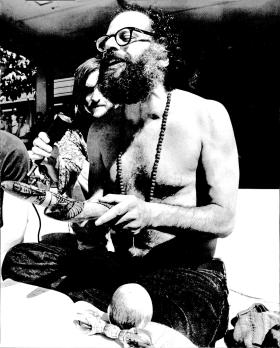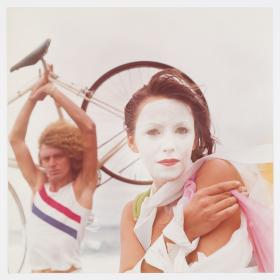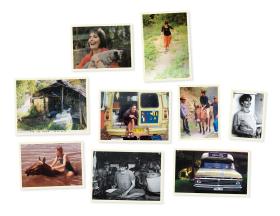At a consciousness-raising meeting in a share house in inner- Melbourne’s Fitzroy, a young schoolteacher called Helen Garner is trying to focus. A visiting American actress, Maggie Helmer, is leading the assembled group of women through improvisation exercises. ‘Start with the phrase, “As a woman I feel like … ” and finish it in your own words,’ she instructs. Helmer is a member of Caravan Theatre, a radical group that staged the first women’s liberation play in the US, and the exercises are from audience workshops she led after their shows. Garner feels so uncomfortable she gets up to leave but, somehow, finding the will to stay, imagines herself as ‘a piece of elastic that is stretched and stretched and stretched’.
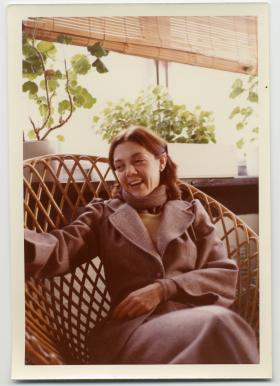
Garner acts out bringing her own baby, Alice, home from hospital. Dwyer plays her husband, Bill Garner. He’s been rehearsing at the Pram Factory, a warehouse the APG had moved into with a plan to stage new Australian plays, and staying out at the pub late into the night. His wife, at home with the baby, feels left out and lonely.
The artist Micky Allan, a friend of both Garner and Dwyer, attends her first women’s meeting the same night she separates from her husband. The couple had returned from London, where her painter husband had set up his studio in their living room while she worked as a relief teacher during the day. She had a little studio in the flat’s closet. She tells her friends that she had turned down paid work at the Pram Factory because it meant she wouldn’t be home in the evenings to have tea on the table for him. But, as David Bowie sang, things were starting to change.
Bowie’s song ‘Changes’ was part of the extraordinary soundtrack to the early 1970s. Like Marvin Gaye’s ‘What’s Going On’ and Helen Reddy’s ‘I am Woman’, it spoke to a time of upheaval and transformation. In the West, a generation rebelled as bombs pounded the Vietnamese. Draft cards were incinerated, the I Ching thrown and Germaine Greer’s explosive words from The Female Eunuch shattered domestic worlds.
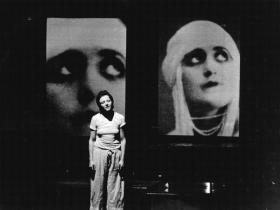
Garner, Allan and Dwyer belonged to a generation of women who’d slipped, almost imperceptibly, through the windows that were opening up to higher education in the 1950s and 1960s. They entered classrooms in old sandstone universities and the new modern campuses filling up with students supported by a Commonwealth Scholarship Scheme. As she walked into the University of Melbourne in 1961, Dwyer recalled feeling shy and unsure of herself, but found herself drawn to student theatre. When an actress in Ray Lawler’s play Summer of the Seventeenth Doll became sick, Dwyer was cast in the role of Pearl.
By 1967, she had enough experience to win a scholarship to study theatre in France, where she took a life-changing class with the experimental Polish theatre director Jerzy Grotowski.
When she returned to Melbourne in 1968, Kerry joined an acting workshop her friends from university had started at La Mama, a little theatre that moved into an old shirt factory in Carlton. The group was inspired by overseas experimental theatre, and Kerry taught them Grotowski’s theory of ‘sacred theatre’. One day, they try facing the wall and throwing their thoughts backwards, and the workshops usually end with dancing or everyone falling in a heap together on the floor, limbs flailing like one huge game of Twister, as if the Hindu gods have become mortal and libidinous Melburnians. The La Mama group staged plays that were by shut down by vice squad detectives when actors uttered strings of expletives.
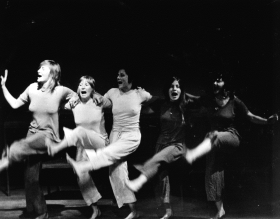
When the workshop, now called the APG, outgrew La Mama, they moved into a former pram factory around the corner in Carlton. They scoured decades of grime and dust away with fire hoses and industrial floor sanders and set about building a new arts culture. Marvellous Melbourne, the APG’s first Pram show, is about the city in the 1880s, but Dwyer’s rage at the play’s focus on the white, Anglo men of Melbourne’s history grows. She storms out of rehearsals.
Inspired by Maggie Helmer’s visit, Dwyer, Garner and Allan invite women from all over Melbourne to a planning meeting at the Pram Factory to discuss a play about women’s lives. Young and middle-aged women come, South Yarra office girls and frustrated housewives, teachers and students. Winsome McCaughey (later to become Lord Mayor of Melbourne) is there, as is folk singer Glen Tomasetti.
They break into small groups to discuss issues the play might cover: the conflict between caring for children and having an intellectual life, lesbianism, sexism in schools and the oppressive notion within heterosexual relationships of women needing to ‘keep their man’. One man attends, brandishing a couple of scripts he’s written. The women ask him to join the large circle, but he storms around the edge and, in a striking example of what we would now call mansplaining, shouts from the top of the rostra: ‘Damn it all! I don’t know how you are going to achieve anything at all if you won’t accept help and advice from us.’ Dwyer writes in her diary, ‘he kept trying to interpret women’s lib for us, but wouldn’t join’.
The group decides to close future meetings to men, and over the following weeks a small group of committed women forms. They settle on a name for their play, Betty Can Jump, a reference to a school reader about two children, John and Betty, playing with stereotypical toys. Roles are cast: Helen Garner, who had no acting experience but was known for writing brilliant letters; Yvonne Marini, who’d left her Greek family home to join the Pram Factory; Jude Kuring, who’d performed in La Mama shows; and Evelyn Krape and Claire Dobbin, who had joined the APG from the drama course at the nearby Secondary Teachers’ College.
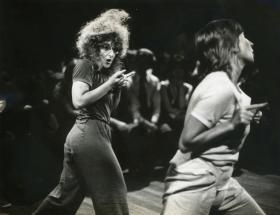
Exploring these archives was an ‘amazing experience for us that none of the other women participated in’, Laurel Frank tells me, when I visit her home and studio in East Brunswick. ‘We were in the library going, “Look at this, look at that!”, discovering and photocopying madly and trying to structure some sort of female history.’ Frank comments that journalist and writer Anne Summers landed on the same material they had found in the Mitchell Library and elsewhere, using it for her classic book Damned Whores and God’s Police.
Betty Can Jump transformed the APG, although not without rancour and at least one spectacular resignation.
Nearly half a century later I had to turn to the Mitchell Library archives too, to learn about the Betty Can Jump women. Growing up in Victoria in the 1970s and 1980s, and living in Carlton and Fitzroy as a student, I had heard of the Pram Factory, but when I thought about the theatre, images of tall men like David Williamson and Bruce Spence came to mind. I knew nothing of the women there. But as I researched their story, I discovered their work was, in many ways, more radical and avant-garde than that created by the Pram men.
I first heard about Betty Can Jump in 2017 when I started a doctorate on the Australian women’s liberation movement. Kerry Dwyer now lives in Sydney, and when I tracked her down on the phone, she told me her records of her Pram Factory years were held in the State Library of NSW. They had not yet been processed, so I needed her permission before the archivists would let me read the material behind the glass panels in the special collections area. When I opened the first of seven boxes in the silent reading space, I kept my excitement to myself when I found not only what seemed to be a Betty Can Jump script (I’d read that no written record of this improvised play existed) but Kerry’s production diaries, and the lengthy interviews she conducted with the Betty collective three years later. The material told a story of a time that was exhilarating and exhausting, frightening and exciting.
Dwyer’s diaries record how Helen Garner (who had started yoga classes with Mrs Mangiamele on Lygon Street when her marriage broke down) led the group in stretches at the beginning of rehearsals. Evelyn Krape, the group’s singer, led vocal warm-ups. Dwyer’s diaries describe the actors’ interactions: ‘Helen is always the one to see a new opening … Jude always on the ground in the middle of it all.’ Evelyn and Yvonne, she writes, ‘riff off each other’ with improvisations that ‘are nearly all funny’.
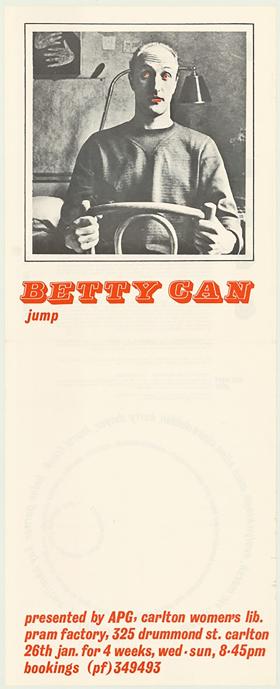
The archives described a marathon rehearsal that went to midnight, when the cast played convicts being whipped and raped by an officer played by Perth actor Victor Marsh. The group had decided they needed a man to play male roles and cast Marsh, who arrived in Melbourne with his partner, a 23-year-old psychology tutor called Carmen Lawrence. Dwyer recalled that with her ‘brilliant mind’, Lawrence helped to knit the historical and contemporary scenes together while watching rehearsals from scaffolded seats above the stage.
The rehearsal period ricocheted between feelings of sisterhood and ‘bad vibes’, as Garner later wrote, which emerged because of the daytime meetings where a smaller group made decisions. Evelyn Krape described the show as an ‘exhilarating opening up’ at a time when her life was changing. Helen Garner remembers it as a time of turmoil: she was ‘freaked out’ by her marriage break-up but was also falling ‘hopelessly in love with one of the other women in the cast’. When I met with Helen Garner she told me now she ‘can hardly think about those years without a sort of angst’. But they were formative. ‘It blew my mind to find that it was possible to set out things that had been on my mind for a long time, things about myself … to find and act out single images of myself as a woman,’ she told Kerry Dwyer in the 1975 interviews.
Dwyer recalls the APG men filing in ‘stony-faced’ for the show’s first run-through at the beginning of 1972. Claire Dobbin remembers feeling full of doubt. ‘Shit, we’re right out of gear … Where’s the dramatic action?’ Helen Garner feels that the play is a failure. But Betty is a huge success.
Women in the audience cry, critics rave, the four-week season is extended by two weeks and the show makes more money than any other APG production that year. Betty Can Jump transformed the APG, although not without rancour and at least one spectacular resignation. As I show in my book, the play helped set the scene for a vibrant women’s theatre movement. The Betty women become known for their influential acting, directing and writing work for stage and screen, for founding Circus Oz, and for making political history — Carmen Lawrence later becomes the first woman elected as Premier of Western Australia. Helen Garner’s books about what it feels like to be a woman will be read around the world, making her one of Australia’s most celebrated writers.
Kath Kenny is an essayist, arts reviewer and researcher. Her book Staging a Revolution: When Betty rocked the Pram has just been published by Upswell.
This story appears in Openbook summer 2022.


